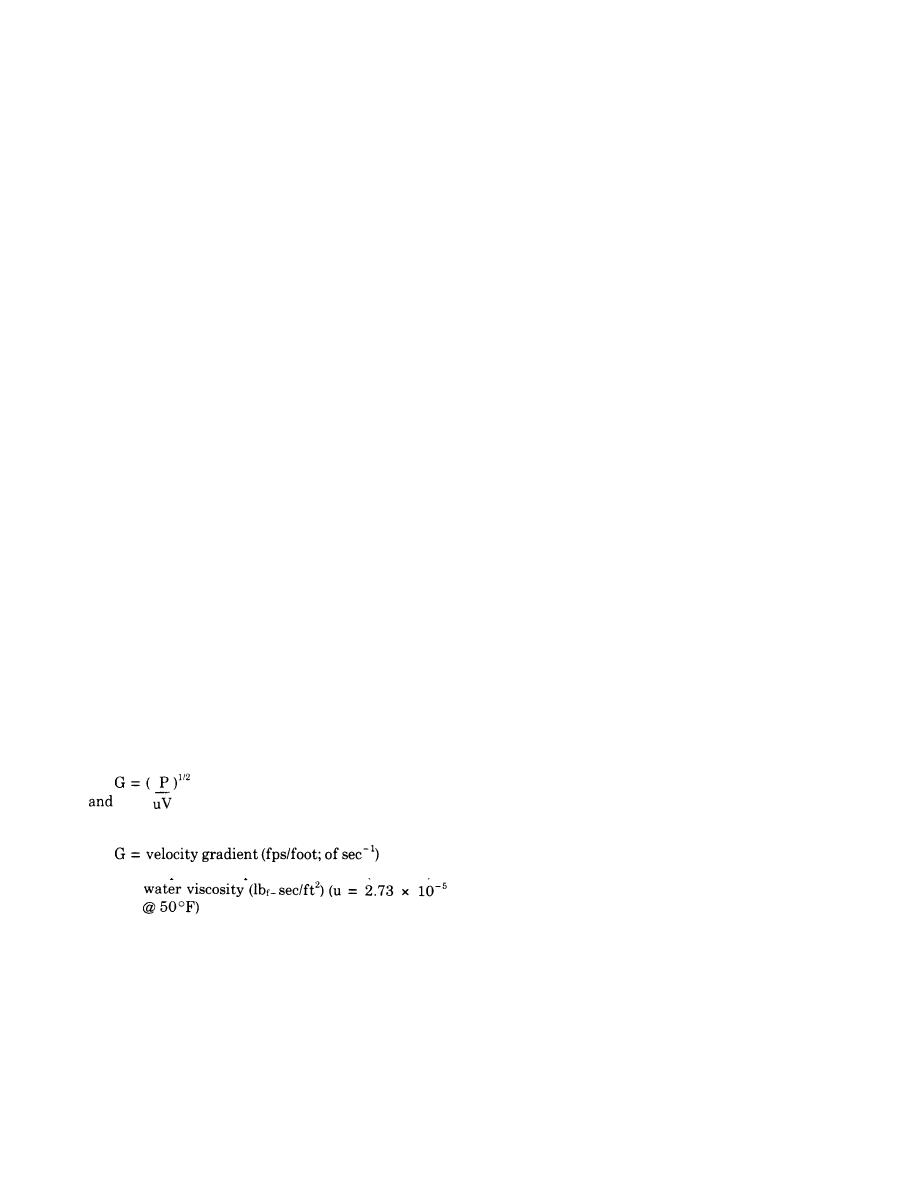
TM 5-813-3/AFM 88-10, Vol 3
onds, yield a G value of about 1000 see-l and a Gt
charged, positively charged or both negatively and
value of 10,000. Similarly, a 30-second detention time
positively charged,
gives a G value of about 600 and a Gt value of 18,000.
c. Coagulation for Removal of Trihalomethane
Long detention period for rapid-mix basins should be
Precursors. Recent US EPA regulations limit allow-
avoided because of higher power requirements and in-
able TTHM concentrations in finished potable water
ferior coagulation results. The rapid-mix basin should
(see para 2-13). To help meet the current maximum
be designed to minimize short circuiting.
contaminant level (MCL) of 0.10 mg/L for TTHM,
f. Slow mix, For slow-mix (flocculating) units, de-
trivalent metal ion coagulant, such as aluminum sul-
tention periods should range from 30 minutes to 60
fate or ferrous sulfate, and a variety of organic poly-
minutes, with installed mixer power of approximately
electrolytes have been used to remove THM precursors
-1
0.1 to 3.5 hp per mgd. G values in the range of 20 see
before chlorination. Naturally-occurring THM precur-
to 100 see-l are commonly employed, Corresponding
sors, such as humic and fulvic compounds, are only
Gt values will, therefore, be in the range of 36,000 to
partially removed by coagulation and filtration. For
360,000. Tapered, slow mixing with G decreasing
coagulation with alum, a pH of between 5 and 6 is the
-
-1
from a maximum of about 90 see l down to 50 see
optimum for the removal of fulvic and humic acid com-
and then to 30 sec -1 can be used and will generally pro-
pounds. Ferrous sulfate exhibits an optimum pH for
duce some improvement in flocculation. Somewhat
removing organic compounds of between 3 and 5. Ful-
-1
higher G values, up to 200 see , are employed in some
vic acids require twice the dosages of alum needed for
water softening plants. For normal flocculation, using
humic acids, The addition of anionic polymers at doses
alum or iron salts, the maximum peripheral speed of
from 1 to 10 mg/L can also provide some removal of
the mixing units should not exceed about 2.0 fps and
humic compounds. The efficiency of removal depends
provision should be made for speed variation. To con-
upon the type and concentration of organic compounds
trol short circuiting, two to three compartments are
present in the water supply, pH, coagulant dose, and
usually provided. Compartmentation can be achieved
solids-liquid separation step. Optimum precursor re-
by the use of baffles. Turbulence following flocculation
moval can only be estimated using laboratory simula-
must be avoided, Conduits carrying flocculated water
tion techniques, such as simple jar testing, followed by
to sedimentation basins should be designed to provide
settling or removal of precipitated colloids with mem-
velocities of not less than 0.5 fps and not more than
brane filters. This procedure can provide the informa-
1.5 fps, Weirs produce considerable turbulence and
tion necessary to determine the optimum conditions
should not be used immediately following flocculation.
for the removal of trihalomethane precursor com-
pounds. Monitoring of the removal of organic precur-
2-5. Sedimentation basins.
sor compounds by coagulation and filtration can be fa-
Sedimentation follows flocculation, The most common
cilitated by the measurement of total organic carbon.
d. Design criteria for mixing. Criteria for rapid- and
types of sedimentation basins in general use are shown
slow-mix processes have been developed on the basis of
in figures 2-1 and 2-2. A recent innovation in clari-
detention time, power input, velocity gradient (G) and
fiers is a helicai-flow solids contact reactor, consisting
the product (Gt) of velocity gradient and detention
of a above ground steel conical basin as shown in fig-
time. The values of G and Gt are computed from:
ure 2-3. However, these above ground basins require a
high head and additional pumps may be required. A
minimum of two basins should be provided to allow
Gt = product of G and t, a dimensionless number
one unit to be out of service for repair or maintenance.
The design must include arrangements that permit use
where
of a single basin when necessary.
P = the power dissipated in the water (ft-lb/see)
a. Design criteria. The design of a sedimentation
u=
tank is based on the criterion as listed in table 2-1,
The sedimentation basins should have adequate capac-
ity to handle peak flow conditions and to prevent ex-
V = volume of mixing basin (cubic feet)
cessive deteriorated effluent water qualities. The
t = mixer detention time (seconds)
above design data represent common conditions,
e. Rapid mixing. For rapid-mix units, detention pe-
higher overflow rates may be used at lime softening
riods usually range from 10 to 30 seconds with in-
plants and at some plants employing upflow clarifica-
stalled mixer power approximately 0,25 to 1.0 hp per
tion units as indicated in the tables of Water Treat-
mgd. Power and detention time should be matched so
ment Plant Design by ASCE, AWWA, CSSE (see app
that values of G will be in the approximate
-1
range: 500-1000 see . A wire-to-water efficiency of
E). Unusual conditions may dictate deviation from
80 percent, a water temperature of 50 `F, a power in-
these general criteria. Detention time in the range of 8
put of 1.0 hp per mgd and a detention time of 10 sec-
to 12 hours, or more provided in several stages, maybe
2-5


 Previous Page
Previous Page
